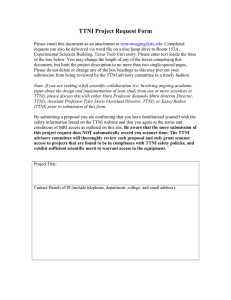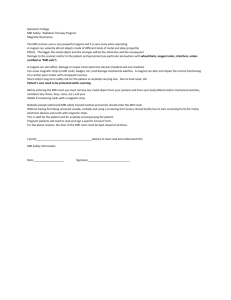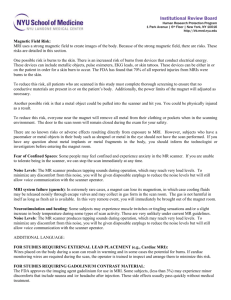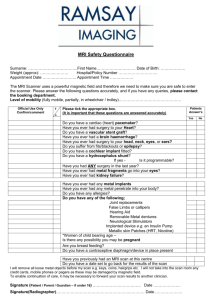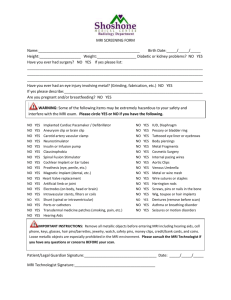MRI Handout for Parents
advertisement
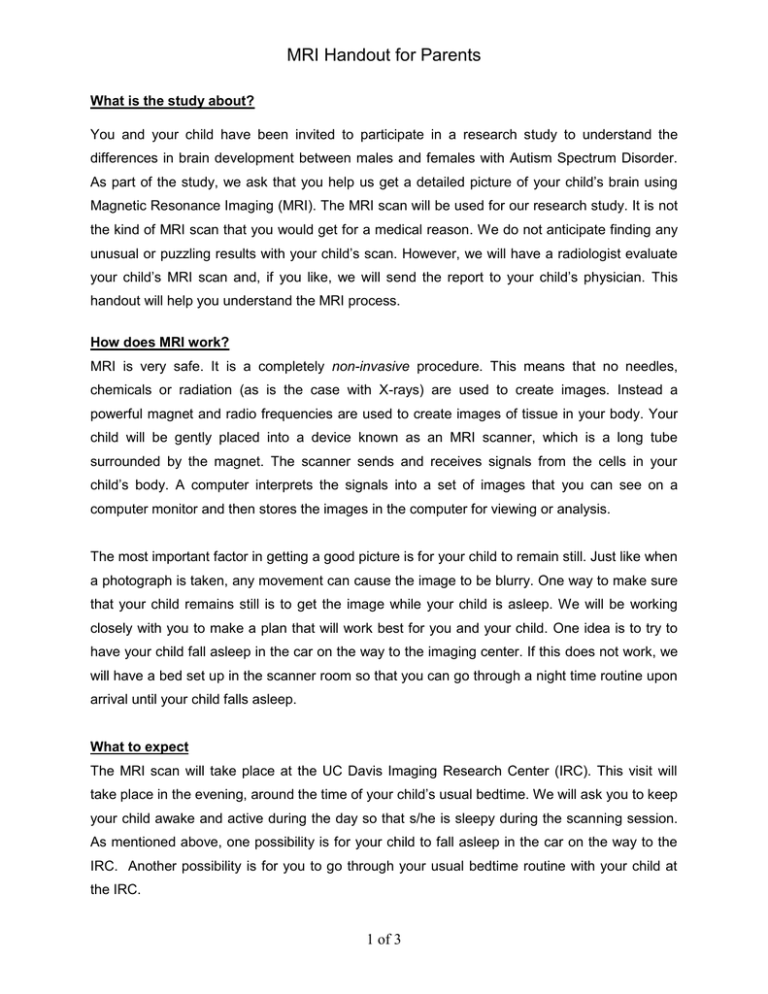
MRI Handout for Parents What is the study about? You and your child have been invited to participate in a research study to understand the differences in brain development between males and females with Autism Spectrum Disorder. As part of the study, we ask that you help us get a detailed picture of your child’s brain using Magnetic Resonance Imaging (MRI). The MRI scan will be used for our research study. It is not the kind of MRI scan that you would get for a medical reason. We do not anticipate finding any unusual or puzzling results with your child’s scan. However, we will have a radiologist evaluate your child’s MRI scan and, if you like, we will send the report to your child’s physician. This handout will help you understand the MRI process. How does MRI work? MRI is very safe. It is a completely non-invasive procedure. This means that no needles, chemicals or radiation (as is the case with X-rays) are used to create images. Instead a powerful magnet and radio frequencies are used to create images of tissue in your body. Your child will be gently placed into a device known as an MRI scanner, which is a long tube surrounded by the magnet. The scanner sends and receives signals from the cells in your child’s body. A computer interprets the signals into a set of images that you can see on a computer monitor and then stores the images in the computer for viewing or analysis. The most important factor in getting a good picture is for your child to remain still. Just like when a photograph is taken, any movement can cause the image to be blurry. One way to make sure that your child remains still is to get the image while your child is asleep. We will be working closely with you to make a plan that will work best for you and your child. One idea is to try to have your child fall asleep in the car on the way to the imaging center. If this does not work, we will have a bed set up in the scanner room so that you can go through a night time routine upon arrival until your child falls asleep. What to expect The MRI scan will take place at the UC Davis Imaging Research Center (IRC). This visit will take place in the evening, around the time of your child’s usual bedtime. We will ask you to keep your child awake and active during the day so that s/he is sleepy during the scanning session. As mentioned above, one possibility is for your child to fall asleep in the car on the way to the IRC. Another possibility is for you to go through your usual bedtime routine with your child at the IRC. 1 of 3 The MRI scanner makes some loud knocking or ringing noises when the pictures are being taken. To protect your child’s ears from the noise of the scanner, we use soft foam earplugs and a set of sound reducing headphones on the night of the scan. In order to help your child get used to wearing the earplugs and headphones while sleeping, we will give you a kit that contains earplugs and headphones to practice with at home. We will give you specific instructions during your first visit. In addition, we will give you a CD of the actual sounds that the scanner will make and ask that you play the CD in the background during the day while your child is awake and at night to help get him/her used to the sounds. You can also play it in the car on the way over to the night time appointment. You can also access the MRI sounds on our study website at mindinstitute.ucdavis.edu/research/app Here are pictures of the real MRI scanner (left) and how the room and scanner will look when you come in for your night time visit (right). The added beds on either side of the MRI bed are in place for your child’s safety and comfort. To help your child fall asleep we have also covered the scanner and added blankets and stuffed animals. When your child falls asleep, s/he will be adjusted into the scanner bed’s head coil. A head coil is used to focus the magnetic field on the right area (the brain) and will also support your child’s head. Pillows, blankets, or towels will be used to comfortably hold your child’s body in position. During the scan, you and one of the researchers will remain in the scanning room with your child (providing that you have nothing that stops you from being in the scanning room – for example, a pacemaker or other implanted medical device). The scan will be stopped immediately and the scanning session will be ended if your child wakes up during the scan and cannot be very quickly soothed back to sleep. Once scanning begins it will take about 30 minutes to take all of the pictures. 2 of 3 Can anyone have an MRI? No, some people cannot have an MRI and should not even be in the same room as an MRI scanner. An MRI machine contains a magnet with a very powerful magnetic force that is never turned off. So no one should enter the scanner room without being carefully screened first. Persons who have a heart pacemaker or any kind of electronic or metal implant in their body should not be in the MRI environment. Some examples of objects that would make an MRI unsafe are: an implanted medication device, such as an insulin pump metal clips or pins, or other metal objects in the head any metal or shrapnel wounds where objects or fragments are lodged around the eye or spinal cord any metal joint replacements or heart valve replacements Also, your child (and the parent who comes into the room with the child), will not be allowed to wear or carry anything metallic in the scanner room. We ask that you dress your child in comfortable pajamas that do not have any zippers or snaps. ALL objects such as watches, jewelry, hair pins, coins, cell phones, keys, or anything else containing metal must be left in the room outside the scanner. Objects containing magnetic data strips, such as credit cards, will have the data erased by the magnet, so they should be left outside as well. provided for safe storage of all such materials. 3 of 3 Lockers are

